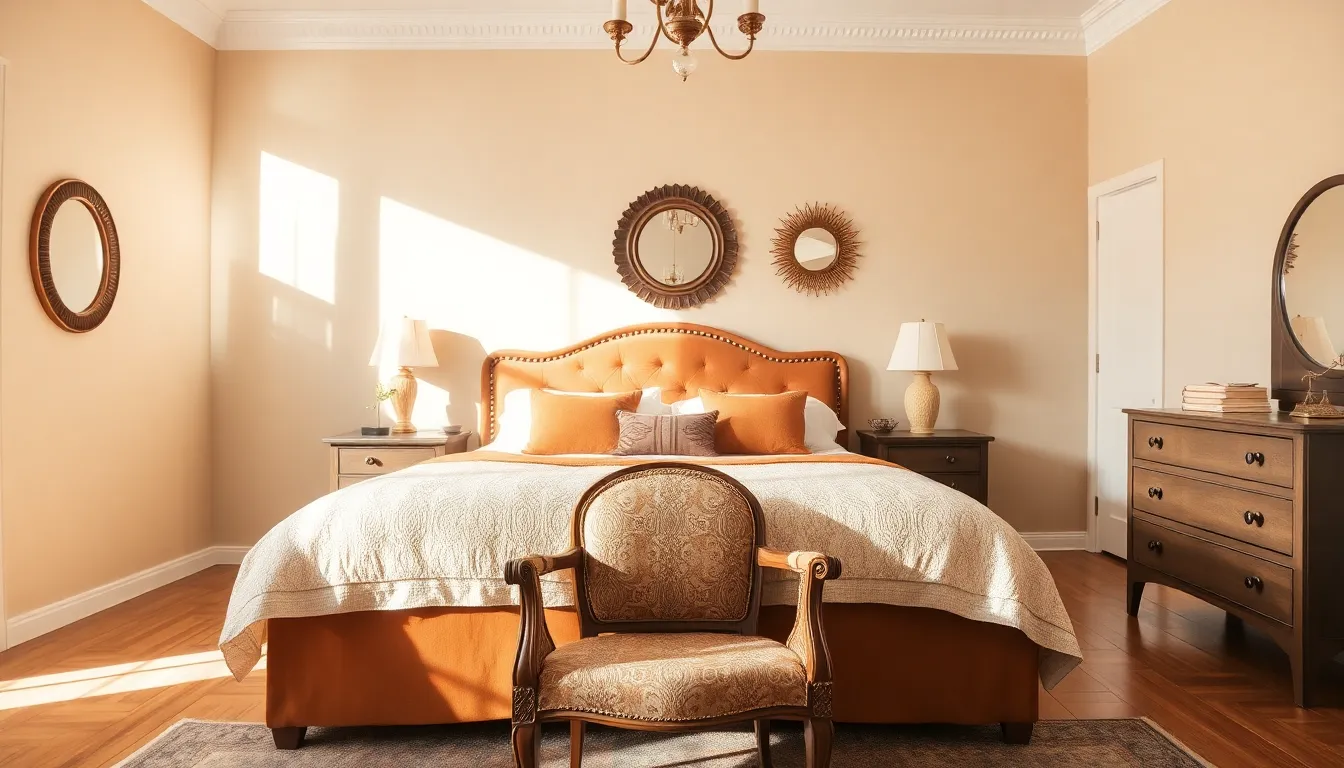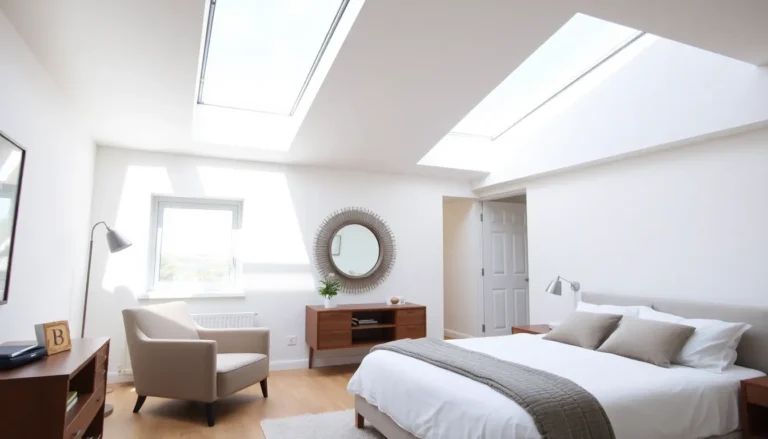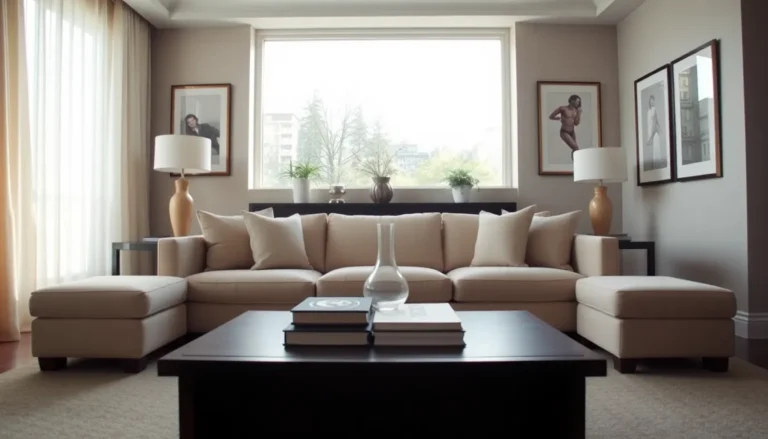Imagine stepping into your bedroom and feeling an instant wave of calm wash over you. The right bedroom layout can transform a chaotic space into a serene sanctuary. It’s not just about where the bed goes; it’s about creating a flow that makes you want to kick off your shoes and dive right into relaxation mode.
Table of Contents
ToggleImportance Of Bedroom Layout
A well-executed bedroom layout significantly enhances comfort and functionality. Furniture arrangement directly impacts daily routines and relaxation levels. Optimal placement of the bed, for example, creates a focal point that encourages restful sleep.
Access to natural light and good airflow contributes to an inviting atmosphere. Each element, from bedside tables to dressers, should complement the overall design to promote harmony. Strategic positioning reduces clutter, making movement more fluid.
Calming colors and textures further elevate the ambiance, transforming the bedroom into a retreat. Prioritizing zoned areas, such as reading nooks or workspace, allows for versatility without sacrificing tranquility. Accessibility to essential items, like lamps and alarm clocks, improves efficiency during busy mornings.
Mindful design choices can also affect mood and well-being. An organized layout minimizes distractions, fostering a peaceful environment conducive to relaxation. Prioritizing personal style within the layout makes the space feel more inviting and tailored to individual preferences.
Using the layout to maximize storage helps maintain cleanliness, ensuring an uncluttered space. Effective use of wall space and multifunctional furniture optimizes room dimensions. Conscious selections in layout balance visual appeal with practical use, creating a serene personal sanctuary.
Key Elements Of A Bedroom Layout

A well-executed bedroom layout includes several key elements that enhance comfort and functionality. These elements create a serene atmosphere conducive to relaxation.
Furniture Arrangement
Arranging furniture impacts the flow and usability of the bedroom. Position the bed as the focal point to promote relaxation and restful sleep. Place bedside tables close by for easy access to essential items. Position dressers and other storage units away from walkways, facilitating fluid movement. Furthermore, incorporating a chair or bench at the foot of the bed offers additional seating and serves as a decorative touch. Adjusting the placement of these pieces ensures optimal space utilization while maintaining an inviting environment.
Space Optimization
Maximizing space transforms any bedroom into a serene retreat. Utilize vertical storage, such as shelving and tall dressers, to free up floor space. Consider multifunctional furniture, like storage ottomans or wall-mounted desks, which provide utility without cluttering the room. Create defined zones for activities, like reading or working, to enhance versatility. Adding mirrors can visually enlarge the space and reflect natural light, contributing to a brighter atmosphere. Thoughtful design choices optimize comfort and promote a sense of tranquility.
Popular Bedroom Layout Styles
Different styles exist for bedroom layouts, each promoting unique aesthetics and functionality. Choices include minimalist and cozy layouts, both catering to specific preferences and lifestyles.
Minimalist Layout
A minimalist layout emphasizes simplicity and clean lines. This style often features a neutral color palette, which creates a calm environment. Furniture selection focuses on essential pieces, with an emphasis on function over form. The bed typically sits centrally, flanked by streamlined bedside tables. Storage solutions often build into walls or utilize under-bed space, effectively reducing clutter. Accessories remain minimal, with single artwork or plants enhancing visual appeal without overwhelming the space. This approach maximizes openness and promotes tranquility, making it ideal for those seeking a serene retreat.
Cozy Layout
A cozy layout centers around comfort and warmth, fostering relaxation. Soft textiles, such as blankets and plush rugs, invite users to unwind. Layered lighting plays a crucial role, often combining ambient, task, and accent lights to create a welcoming atmosphere. The bed, usually positioned against the wall, serves as the room’s focal point, adorned with inviting pillows. Additional seating, like a cozy armchair or window seat, enhances a snug vibe. Personal touches, including family photos or cherished items, add character while creating a sense of belonging. This style balances aesthetics and comfort, significantly enhancing the overall ambiance.
Tips For Designing An Effective Bedroom Layout
Creating an effective bedroom layout requires thoughtful consideration of various elements that enhance both comfort and functionality. Implementing these tips can transform any bedroom into a serene personal sanctuary.
Consideration Of Natural Light
Natural light plays a vital role in developing an uplifting bedroom atmosphere. Positioning the bed near windows maximizes exposure to daylight, offering a refreshing start to the day. Using sheer curtains allows for light filtration while maintaining privacy. Skylights can also add valuable sunlight, especially in rooms with limited wall space. Positioning mirrors across from windows reflects light, enhancing brightness in darker corners. Incorporating light-colored walls can amplify the effect, making the room feel more spacious. Aim for a balance where light promotes energy while ensuring there are cozy, shaded spots for rest.
Balancing Functionality And Aesthetics
Achieving a balance between functionality and aesthetics enhances bedroom usability and visual appeal. Arranging furniture to facilitate easy movement is crucial; placement of bedside tables alongside the bed allows for convenience. Selecting multifunctional furniture, such as storage ottomans, decreases clutter without sacrificing style. Artwork and decorative elements should complement the overall design, ensuring they don’t overwhelm the space. Adding soft textures through bedding and rugs contributes to comfort and warmth, enriching the sensory experience in the room. Choose colors and patterns that evoke tranquility while aligning with personal tastes, ensuring the space feels inviting and coherent.
A thoughtfully designed bedroom layout can significantly enhance the overall atmosphere of the space. By focusing on furniture arrangement and optimizing natural light, individuals can create a serene retreat that promotes relaxation and well-being. Prioritizing comfort through multifunctional furniture and defined zones allows for a balance between aesthetics and practicality.
Incorporating personal touches and mindful design choices transforms the bedroom into a sanctuary that reflects individual style while fostering tranquility. Ultimately, a well-executed layout not only elevates the visual appeal but also contributes to a more peaceful and organized environment. Embracing these principles will lead to a restful haven that supports daily routines and rejuvenation.





